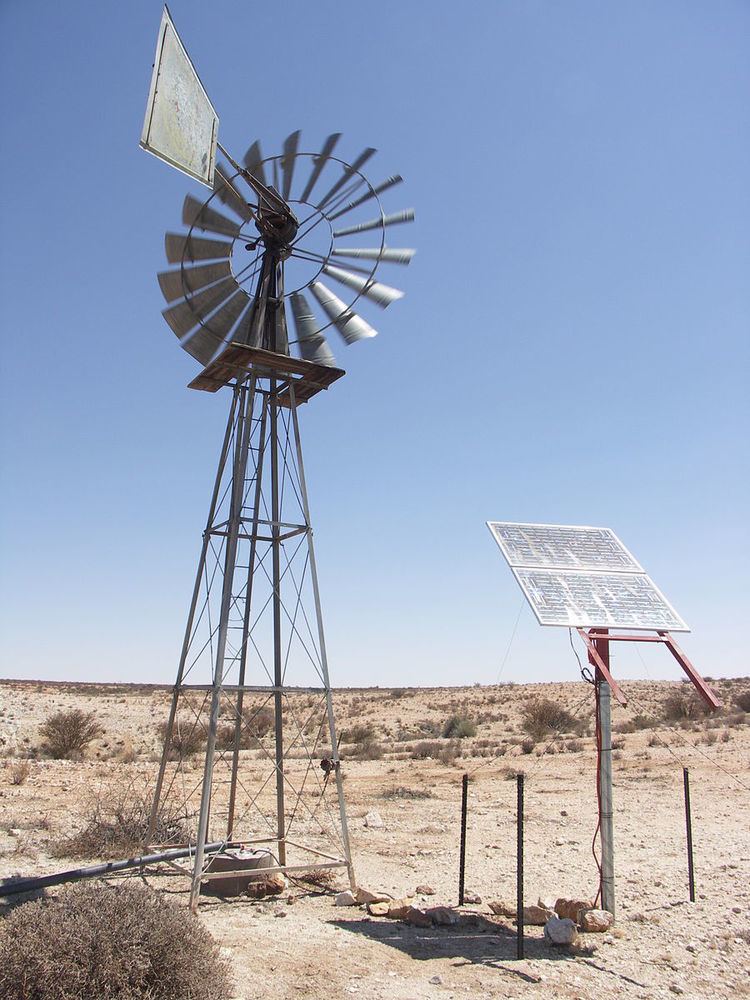 | ||
A solar-powered pump is a pump running on electricity generated by photovoltaic panels or the radiated thermal energy available from collected sunlight as opposed to grid electricity or diesel run water pumps. The operation of solar powered pumps is more economical mainly due to the lower operation and maintenance costs and has less environmental impact than pumps powered by an internal combustion engine (ICE). Solar pumps are useful where grid electricity is unavailable and alternative sources (in particular wind) do not provide sufficient energy.
Contents
Components
A photovoltaic solar powered pump system has three parts:
The solar panels make up most (up to 80%) of the systems cost. The size of the PV-system is directly dependent on the size of the pump, the amount of water that is required (m³/d) and the solar irradiance available.
The purpose of the controller is twofold. Firstly, it matches the output power that the pump receives with the input power available from the solar panels. Secondly, a controller usually provides a low voltage protection, whereby the system is switched off, if the voltage is too low or too high for the operating voltage range of the pump. This increases the lifetime of the pump thus reducing the need for maintenance.
Voltage of the solar pump motors can be AC (alternating current) or DC (direct current). Direct current motors are used for small to medium applications up to about 3 kW rating, and are suitable for applications such as garden fountains, landscaping, drinking water for livestock, or small irrigation projects. Since DC systems tend to have overall higher efficiency levels than AC pumps of a similar size, the costs are reduced as smaller solar panels can be used.
Finally, if an alternating current solar pump is used, an inverter is necessary that changes the direct current from the solar panels into alternating current for the pump. The supported power range of inverters extends from 0.15 to 55 kW and can be used for larger irrigation systems. However, the panel and inverters must be sized accordingly to accommodate the inrush characteristic of an AC motor.
Water pumping
Solar powered water pumps can deliver drinking water as well as water for livestock or irrigation purposes. Solar water pumps may be especially useful in small scale or community based irrigation, as large scale irrigation requires large volumes of water that in turn require a large solar PV array. As the water may only be required during some parts of the year, a large PV array would provide excess energy that is not necessarily required, thus making the system inefficient.
Solar PV water pumping systems are used for irrigation and drinking water in India. The majority of the pumps are fitted with a 2000 watt - 3,700 watt motor that receives energy from a 4,800 Wp PV array. The 5hp systems can deliver about 124,000 liters of water/day from a total of 50 meters setoff head and 70 meters dynamic head. By 30 August 2016, a total of 1,20,000 solar PV water pumping systems have been installed in INDIA.
Oil and gas
In order to combat negative publicity related to the environmental impacts of fossil fuels, including fracking, the industry is embracing solar powered pumping systems. Many oil and gas wells require the accurate injection (metering) of various chemicals under pressure to sustain their operation and to improve extraction rates. Historically, these chemical injection pumps (CIP) have been driven by gas reciprocating motors utilizing the pressure of the well's gas and exhausting the raw gas into the atmosphere. Solar powered electrical pumps (solar CIP) can reduce these greenhouse gas emissions. Solar arrays (photovoltaic cells) not only provide a sustainable power source for the CIPs but can also provide an electric source to run remote SCADA type diagnostics with remote control and satellite/cell communications from very remote locations to a desktop or notebook monitoring computer.
Stirling engine
Instead of generating electricity to turn a motor, sunlight can be concentrated on the heat exchanger of a Stirling engine and used to drive a pump mechanically. This dispenses with the cost of solar panels and electric equipment. In some cases the Stirling engine may be suitable for local fabrication, eliminating the difficulty of importing equipment. One form of Stirling engine is the fluidyne engine which operates directly on the pumped fluid as a piston. Fluidyne solar pumps have been studied since 1987 At least one manufacturer has conducted tests with a Stirling solar powered pump.
